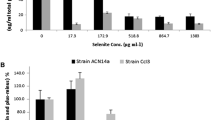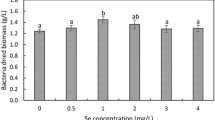Abstract
Selenium accumulation and the growth of cyanobacterium Spirulina platensis (Nordst.) Geitl. were studied in a culture with sodium selenite-supplemented nutritional medium. Selenite concentrations below 20 mg/l did not inhibit the growth of S. platensis. The addition of 30 mg/l of this salt somewhat decreased the growth rate during the linear growth phase, induced the earlier suspension transition to the steady-state phase, and substantially lowered the highest optical density of the suspension. However, even at 170 mg/l Na2SeO3, the culture still demonstrated a capacity for growth. The content of selenium in the cells depended directly on its concentration in the medium, up to the lethal level. At high selenium concentrations (100–170 mg/l), S. platensis reduced Se(IV) up to Se(0). The latter was secreted onto the cell surface and into the cultural medium. The high concentrations of Na2SeO3 acidified the cytoplasmic pH as was measured by 31P-NMR spectroscopy. At the same time, the content of protein on a dry weight basis decreased and that of carbohydrates and lipids somewhat increased, just as was observed in S. platensis cells under other stress factors. In the presence of 20 mg/l Na2SeO3, the selenium content in the biomass increased by 20 000 times as compared to that in the control cells, whereas the biochemical composition of biomass did not change. In this case, the selenium was incorporated almost completely in the protein fraction. The selenium concentration in this fraction increased more significantly when the sulfur content was lowered in the medium.
Similar content being viewed by others
REFERENCES
Richmond, A., Microalgae of Economic Potential, Handbook of Microalgal Mass Culture, Richmond, A., Ed., Boca Raton: CRC, 1986, pp. 199-244.
Borowitzka, M.A. and Borowitzka, L.J., Dunaliella, Micro-Algal Biotechnology, Borowitzka, M.A. and Borowitzka, L.J., Eds., Cambridge: Cambridge Univ. Press, 1988, pp. 27-59.
Tsoglin, L.N. and Gabel', B.V., Potential Productivity of Microalgae in Industrial Photobioreactor, Fiziol. Rast. (Moscow), 2000, vol. 47, pp. 761-767 (Russ. J. Plant Physiol., Engl. Transl.).
Trubachev, I.I., Gitelzon, I.I., Kalacheva, G.S., Barashkov, V.A., Belyanin, V.I., and Andreeva, V.I., Biochemical Composition of Blue-Green Algae and Chlorella, Prikl. Biokhim. Mikrobiol., 1976, vol. 12, pp. 200-208.
Klyachko-Gurvich, G.L., On Directed Biosynthesis of Proteins, Carbohydrates, and Lipids in Chlorella Cells, Upravlyaemyi biosintez (Directed Biosynthesis), Ierusalimskii, N.D. and Kovrov, B.G., Eds., Moscow: Nauka, 1966, pp. 116-121.
Semenenko, V.E., Self-Regulation of Physiological Functions and Monitoring of the Biosynthesis of Photosynthesizing Cells, Novye napravleniya v fiziologii rastenii (New Trends in Plant Physiology), Kursanov, A.L., Ed., Moscow: Nauka, 1985, pp. 85-104.
Tambiev, A.Kh., Kirikova, N.N., Mazo, V.K., and Skal'nyi, A.V., Method for Production of Selenium-Containing Preparation from Spirulina Biomass, Patent RF 2096037, class A 61 K 33/04, 1998.
Varga, L., Sziget, J., and Ordog, V., Effect of Spirulina platensis Biomass Enriched with Trace Elements on Combinations of Starter Culture Strains Employed in the Dairy Industry, Michwissenschaft, 1999, vol. 54, pp. 247-248.
Minyuk, G.M., Trenkenshu, R.P., Alisevich, A.V., and Drobetskaya, I.V., Selenium Effect on the Growth of Microalga Spirulina platensis (Nordst.) Grown as Batch and Quasicontinuous Cultures, Ekologiya Morya, 2000, vol. 54, pp. 42-49.
Mazo, V.K., Gmoshinskii, I.V., Tambiev, A.Kh., Kirik-ova, N.N., and Golubkina, N.A., The Effect of Biologically Active Food Supplements Enriched in Available Selenium on the Development of Systemic Anaphylaxis in Rats, Biotechnologiya, 1997, nos. 9-10, pp. 45-48.
Reshetnik, L.A. and Parfenova, E.O., Selenium and Human Health (Review of the Literature Data), Ekologiya Morya, 2000, vol. 54, pp. 20-25.
Golubkina, N.A., Shagova, M.V., Baturin, A.K., and Khotimchenko, S.A., The Selenium Providing of Inhabitants in Altai Region, Vopr. Pitaniya, 1998, no. 5-6, pp. 16-18.
Golubkina, N.A., The Role of Medicine Plant in the Formation of Selenium Status of Russia Population, Doctoral (Agric.) Dissertation, Moscow: Timiryazev Agric. Acad., 1999.
Wheeller, A.E., Zingaro, R.A., and Irgolic, K., The Effect of Selenate, Selenite, and Sulfate on the Growth of Six Unicellular Marine Algae, J. Exp. Mar. Biol. Ecol., 1982, vol. 5, pp. 181-194.
Wehr, J.D. and Brown, L.M., Selenium Requirement of Bloom-Forming Planktonic Algae from Softwater and Acidified Lakes, Can. J. Fish. Aquat. Sci., 1985, vol. 42, pp. 1983-1997.
Riedel, G.F., Sanders, J.G., and Gilmour, C.C., Uptake, Transformation, and Impact of Selenium in Freshwater Phytoplankton and Bacterioplankton Communities, Aquat. Microbiol. Ecol., 1996, vol. 11, pp. 43-51.
Katalog kul'tur mikrovodoroslei v kollektsiyakh SSSR (Catalogue of Microalgal Cultures in the Collection of USSR), Semenenko, V.E., Ed., Moscow: Inst. Fiziol. Rast. Ross. Akad. Nauk, 1991.
Sharenkova, Kh. and Semenenko, V.E., Characteristics of Photosynthetic Oxygen Evolution by Spirulina platensis (Gom.) Geitl., Fiziol. Rast. (Moscow), 1982, vol. 29, pp. 572-571 (Sov. Plant Physiol., Engl. Transl.).
Lowry, D., Rosebrough, N., Farr, A., and Randal, R., Protein Measurement with the Folin Phenol Reagent, J. Biol. Chem., 1951, vol. 193, pp. 265-275.
Sergeenko, T.V., Muradyan, E.A., Pronina, N.A., Kly-achko-Gurvich, G.L., Mishina, I.M., and Tsoglin, L.N., The Effect of Extremely High CO2 Concentration on the Growth and Biochemical Composition of Microalgae, Fiziol. Rast. (Moscow), 2000, vol. 47, pp. 722-729 (Russ. J. Plant Physiol., Engl. Transl.).
Klyachko-Gurvich, G.L., Directed Biosynthesis of Carbohydrates in Chlorella, Fiziol. Rast. (Moscow), 1964, vol. 11, pp. 978-987 (Sov. Plant Physiol., Engl. Transl.).
The Methods of Protein and Amino Acid Analysis in Plants, Metodicheskie ukazaniya (Methodological Recommendations), Konarev, V.G., Ed., Leningrad: Vses. Nauch.-Issled. Inst. Rastenievodstva, 1973.
Roberts, J.K.M., Study of Plant Metabolism in vivo Using NMR Spectroscopy, Annu. Rev. Plant Physiol., 1984, vol. 35, pp. 375-386.
Kichitsu, K., Katsuhara, M., and Miyachi, S., Rapid Cytoplasmic Alkalization and Dynamics of Intracellular Compartmentation of Inorganic Phosphate during Adaptation against Salt Stress in a Halotolerant Unicellular Green Alga Dunaliella tertiolecta: 31 P-Nuclear Magnetic Resonance Study, Plant Cell Physiol., 1989, vol. 30, pp. 407-414.
Handbook of Inductive Coupled Plasma Mass-Spectrometry, Javis, K.E., Grey, A.L., and Houk, R.S., Eds., New York: Chapmen and Hall, 1992.
Golubkina, N.A., Fluorometric Method of Selenium Determination, Zh. Anal. Khim., 1995, vol. 50, pp. 492-497.
Upitis, V.V., Makro-i mikroelementy v optimizatsii mineral'nogo pitaniya mikrovodoroslei (Macro-and Micro-nutrients at the Optimization of Mineral Nutrition), Riga: Zinatne, 1983.
Koval'skii, V.V., Geokhimicheskaya ekologiya (Geochemical Ecology), Moscow: Nauka, 1974.
Minyuk, G.S. and Drobetskaya, I.V., The Effect of Selenium on the Life of Marine and Freshwater Microalgae (Review), Ekologiya, morya, 2000, vol. 54, pp. 26-37.
Bottino, N.R., Banks, C.H., and Irgolic, K.J., Selenium-Containing Amino Acids and Protein in Marine Algae, Phytochemistry, 1984, vol. 23, pp. 2445-2452.
Vandermeulen, J.H. and Foda, A., Cycling of Selenite and Selenate in Marine Phytoplankton, Mar. Biol., 1988, vol. 98, pp. 115-123.
Shrift, A., Sulfur-Selenium Antagonism: 1. Antimetabolite Action of Selenate on Growth of Chlorella vulgaris, Am. J. Bot., 1954, vol. 41, pp. 223-230.
Trenkenshu, R.P. and Drobetskaya, I.V., The Effect of Sulfur and Selenium Antagonism on the Growth and Biochemical Parameters of Spirullina, Ekologiya Morya, 2000, vol. 54, pp. 50-56.
Author information
Authors and Affiliations
Rights and permissions
About this article
Cite this article
Pronina, N.A., Kovshova, Y.I., Popova, V.V. et al. The Effect of Selenite Ions on Growth and Selenium Accumulation in Spirulina platensis. Russian Journal of Plant Physiology 49, 235–241 (2002). https://doi.org/10.1023/A:1014809825140
Issue Date:
DOI: https://doi.org/10.1023/A:1014809825140




